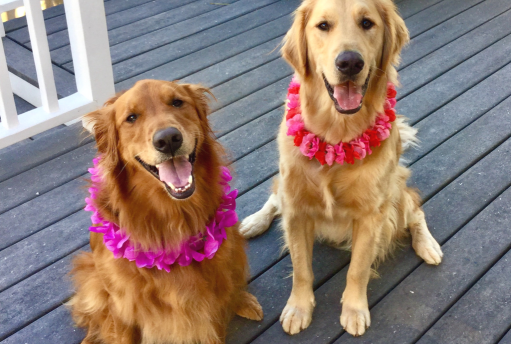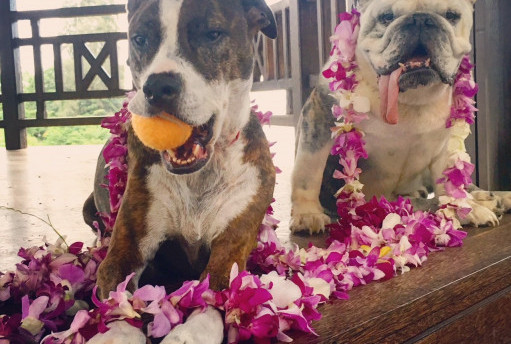Planning to bring your furry family member to Hawaii? The white sand beaches and palm trees of the Aloha State are waiting, but before shipping pets to Hawaii there are some important considerations. From vaccinations to blood tests, pet transport to Hawaii is a complex process that is made easier when working with a qualified company. Let our team of experts guide you through the involved process of bringing a pet to Hawaii. We'll help you understand the necessary requirements, so you don't have to navigate it alone.
Need Our Support?
What to Know Before Bringing Dogs and Cats to Hawaii
-
Microchip and Vaccinations
Make sure your pet meets these basic requirements so you can begin the import process.
-
Blood Tests and Other Treatments
The timeline for travel starts with your pet's first rabies vaccine.
-
Veterinary Credentials
Any veterinarian may administer the rabies vaccines, but the titer blood draw must be performed by a USDA accredited veterinarian.
-
Import Documentation
Once your pet's blood test is completed, the documentation process begins!
-
Quarantine and other information
If you follow our guidelines, your pet should not need quarantine in Hawaii.
-
If Honolulu is not your destination
If the island of Oahu is not your final destination, there are additional steps.
Hawaii Pet Import Requirements and Timeline

Microchip and Vaccinations
Time frame: at least 90 days before departure date.
Transporting your furry family member to Hawaii can be a complicated process with numerous requirements and regulations to consider. Our team of experts understands the complexities involved with shipping pets to Hawaii and will manage your pet's entire move, including coordinating vet visits and ensuring all necessary documents are filled out correctly the first time.
Hawaii has specific requirements for vaccinations and a blood test, which usually entails multiple visits to the vet. We take care of all these appointments, and also provide sample documents to ensure that everything is completed correctly. Our relocation coordinators stay up-to-date on regulatory changes, so you and your vet can rest easy.
To enter Hawaii, your pet must be microchipped and vaccinated. More detailed information on specific requirements can be found below. With our support, you can be sure that your furry friend arrives in Hawaii safe and sound.
How to start the process of moving your pet to Hawaii.
Microchip
- Pets must have an electronic microchip implanted (required before an OIE-FAVN rabies blood test is performed).
- Your veterinarian must scan the microchip to verify that it is working and that the microchip number is correct on all documentation.
- If the pet cannot be identified by scanning the microchip, it will not qualify for direct airport release and undergo up to 120-day quarantine.
- Ensure that the microchip information is accurate and up-to-date before traveling to Hawaii to avoid any issues with identification and direct airport release.
Rabies Vaccination and Certificate
- Pets should be vaccinated at least twice for rabies in their lifetime. These rabies vaccines should be administered more than 30 days apart.
- The most recent rabies vaccination should be done no more than 12 months before the date of arrival in Hawaii for a 1-year rabies vaccine or no more than 36 months before the date of arrival for a 3-year rabies vaccine.
 Beau: California to Hawaii 2019
Beau: California to Hawaii 2019
FAVN Blood Test
Make sure testing and treatments are done on time.
To avoid a stay in quarantine in Hawaii, make sure your pet has their vaccine and blood test done at the correct time.
Make sure strict timelines are met.
OIE-FAVN Rabies Blood Test
First, ensure your pet has a valid rabies vaccine (at least the second vaccine they have had). Once that rabies vaccine is at least 30 days old, your pet must have their blood drawn for a rabies antibody test by an accredited veterinarian to ensure that the vaccination has provided adequate rabies antibody levels.
- A blood sample must be sent to Kansas State University (KSU) or the DOD Food Analysis and Diagnostic Laboratory in Texas. Blood test results must be equal to 0.5 IU/ml. Or greater.
- You must have a copy of the successful blood test results showing the pet's microchip number.
- Make sure your veterinarian lists "Hawaii" as the destination on the blood test submission form. KSU and DOD will then automatically send your pet's results to Hawaii.
- It's important to note that the OIE-FAVN rabies blood test must be done no earlier than 120 days before the pet arrives in Hawaii and no later than 36 months before coming for a 3-year rabies vaccine or 24 months for a 1-year vaccine. Failure to complete the blood test within the required time frame can result in the pet being denied entry into Hawaii or placed in quarantine.
 Penny: Illinois to Hawaii 2015.
Penny: Illinois to Hawaii 2015.
Veterinary Credentials
Time frame: at least 30 days after your pet's most recent first rabies vaccine.
Your veterinarian must issue two signed rabies vaccine certificates and submit the blood draw for the rabies titer test to an approved lab.
What happens if your veterinarian isn't accredited?
- Your dedicated relocation coordinator has likely already worked with an accredited vet in your area, or can recommend one.
- At this stage, we provide detailed templates for your veterinarian and answer any questions regarding the proper completion of the required form.
- It's not uncommon for a client's veterinarian to lack these required credentials for import. However, we can provide guidance with this process if they'd like to become accredited.
- Did you know about the timeline for the final vet visit? In order to avoid delays, we include this in our service with a veterinarian we know and trust with international travel preparation!
 Cody and Cooper: Tennessee to Hawaii 2017
Cody and Cooper: Tennessee to Hawaii 2017
Import Documentation
Time frame: within 10 days of departure.
Once you have your test results back, you'll need to make an appointment with a USDA-accredited veterinarian within 10 days of your planned travel date.
Avoid paperwork headaches by hiring experienced pet movers.
Submission of Documents
You are required to submit the following documentation to the Hawaii Rabies Quarantine Branch. All documentation listed below must be received at least 10 days before your pet's arrival in Hawaii to ensure direct release.
- Completed Dog & Cat Import Form AQS-279.
- Two original rabies vaccination certificates with actual veterinarian signature.
- Fee payments are accepted by cashier’s check or money order only (pet’s microchip number must be included with payment), payable to the Department of Agriculture
- $185/pet in advance for direct airport release. Please note if your documentation arrives less than 10 days before your pet's arrival, you will be subject to a higher fee per pet.
You may send the listed documentation by mail with a return receipt to Animal Quarantine Station 99-951 Halawa Valley St., Aiea, Hawaii 96701.
Final Veterinary Appointment
Within 10 days of travel to Hawaii, your pet must see their USDA-accredited veterinarian. Your vet must issue a domestic health certificate, or APHIS-7001, deeming your pet healthy enough for pet travel. This document does not need to be endorsed by the USDA. This original health certificate and copies of the rabies certificates and titer test results must travel with your pet.
Pets must be treated for ticks with a Fipronil product or an equivalent, long-acting product (Revolution is unacceptable) within 14 days of arrival. The product name and treatment date should be recorded on the health certificate issued by the USDA-accredited veterinarian.
 Sweet Jane: California to Hawaii 2018
Sweet Jane: California to Hawaii 2018
Quarantine and other information
Your pet should be able to avoid quarantine in Hawaii.
If your pet does not meet the above requirements upon entry to Hawaii, they must complete 30-120 days of quarantine.
Additional Information.
Direct Release at the Airport
Direct Airport Release is only done at the Honolulu International Airport. This is PetRelocation's preferred method of entry into Hawaii.
- Pets must arrive at the Airport Animal Quarantine Holding Facility (808-837-8092) at the Honolulu International Airport during regular inspection hours of 8:00 a.m. to 4:30 p.m. Remember that it may take up to one hour for the airlines to transport your pet to the Airport Animal Quarantine Holding Facility.
- Pets not arriving at the facility during regular inspection hours will not be released at the airport, so it is important to note that your pet's flight will need to arrive no later than 3:30 p.m. in Honolulu if you would like to have your pet released the same day.
- Pets on international flights will also need to clear US Customs before they may be released from the Airport Animal Quarantine Holding Facility. You may check with your airline regarding US Customs hours of operation or ask your PetRelocation relocation coordinator.
- Pets will not qualify for direct airport release if ticks or other parasites are found upon arrival.
- It's important to note that Hawaii has a zero-tolerance policy for pets that have not completed the requirements for direct airport release. Any pets not meeting the requirements will be subject to quarantine for up to 120 days. Pet owners should be aware that the cost of quarantine can be high and plan accordingly. Additionally, it's essential to ensure that all necessary paperwork is completed accurately and submitted on time to avoid delays.
 Miles and Lola: Washington to Hawaii 2018
Miles and Lola: Washington to Hawaii 2018
If Honolulu is not your destination
Transiting through Honolulu or flying directly to another island.
Honolulu is the only airport in the Hawaiian islands that has an animal quarantine facility. While it may be possible to fly directly to other destinations with your pet, there are additional steps that must be taken.
Pet movers to Hawaii can help you navigate these extra considerations depending on your final destination.
Extra steps you need to take.
Transiting Through Honolulu
Many pet owners will have a layover in Honolulu before continuing to their final destinations within the Hawaiian Islands. In this case, your pet may follow the import guidelines. Make sure to allow your pet enough time between flights to have their documentation cleared for import.
Please note: Only cats and dogs fully meeting import requirements may fly directly onto a neighboring island. Any other species must enter through the Honolulu airport's animal quarantine facility. Cats and dogs who do not fully meet the import requirements must complete their 30-120 days quarantine in the Honolulu Animal Quarantine Station.
Flying Directly Into a Neighboring Island
If Honolulu is not your pet's final destination, they may fly directly into a neighboring island, such as Maui or Hawai'i (The Big Island). However, the following steps must be taken:
- All of the submission documentation mentioned previously, along with payment, must be received by the Animal Quarantine Station at least 30 days before your pet arrives.
- Since no animal quarantine facility exists at any Hawaiian airport besides Honolulu, pet owners must hire an accredited veterinarian to meet their pets upon arrival. The veterinarian will then approve all paperwork and clear the pet through customs.
- Your pet must still see a USDA-accredited veterinarian and receive an APHIS-7001 health certificate within ten days of travel.
- It is important to note that if your pet is flying directly into a neighboring island, you must ensure that your airline allows pets to travel in the cabin or as checked baggage. Some airlines may not allow pets to travel on inter-island flights, so it is best to check with your airline beforehand.




